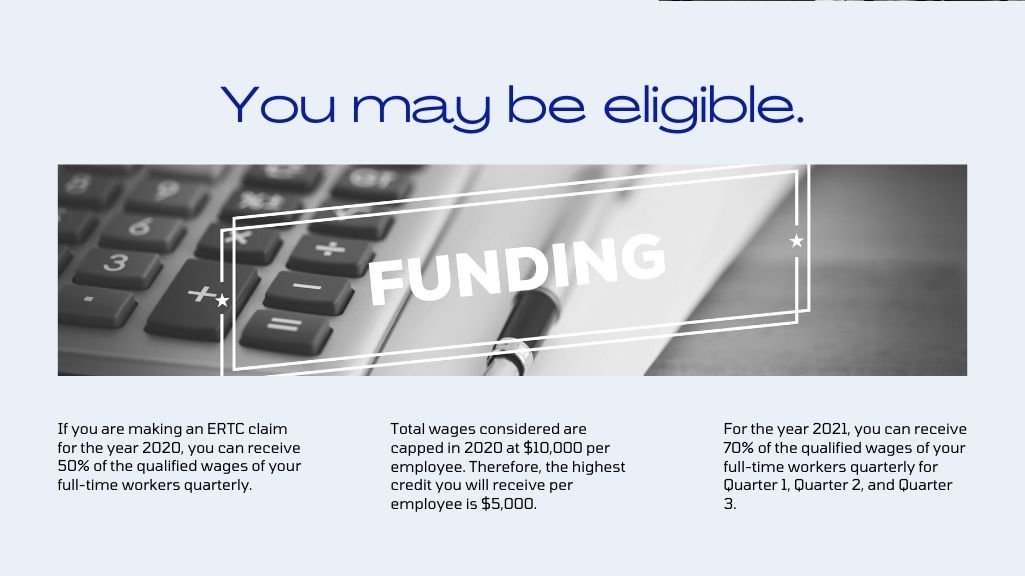The success of a recovery startup business depends on its ability to retain employees. With the introduction of the Employee Retention Tax Credit, businesses now have an additional tool that can help them keep their workforce and ensure long-term stability.
This article provides an overview of how the recovery startup business ERTC Employee Retention Tax Credit works and how it can assist with employee retention in recovery startups to aid its capability to retain employees and ensure long-term stability.
The Employee Retention Tax Credit (ERTC) was introduced as part of the Coronavirus Aid, Relief, and Economic Security Act (CARES Act). It allows employers who experienced reduced revenue or had to close during 2020 due to the pandemic to receive a refundable payroll tax credit for each qualified employee they retained through December 31st.
This incentive is designed to support businesses struggling with economic hardship by providing financial assistance for retaining their staff members throughout the year.
Overview of the Employee Retention Tax Credit
The Employee Retention Tax Credit (ERTC) has been gaining traction in recent years as a tool for small businesses to retain their employees and recover from the economic impact of the COVID-19 pandemic. This tax credit can provide employers with up to $5,000 per employee each year they are employed by the company, making it an attractive incentive to help companies keep their workforce intact.
But how much do we really know about this tax relief option? Can it truly make a difference in helping struggling startups remain operational?

In order to understand its potential effectiveness at providing relief, let’s take a look at some key facts regarding the ERTC.
First off, although not all employers qualify for the full amount available through this program, many small business owners could still benefit significantly if they meet certain criteria.
Most who receive the credit won’t have to pay any additional taxes on top of what is already owed; instead, those eligible will enjoy a total reduction in current tax liability or even receive a refund check from Uncle Sam.
Since eligibility requirements vary based on your particular situation – such as whether you’re self-employed versus having multiple employees – it’s important that you review all of your options before deciding which route is best for you and your business.
There’s no denying that this type of tax break could be game-changing for many businesses hit hard by the pandemic. Now that we’ve gotten an overview of what makes up this financial aid opportunity, let’s dive into exactly what qualifies one for receiving these funds and other considerations related to taking advantage of this program.
Qualifying Criteria
Employee retention tax credits are becoming increasingly popular among startup businesses as a way to invest in their staff and show appreciation for their hard work. Companies that qualify for the credit can receive up to $5,000 per employee, making it an attractive option for businesses looking for ways to attract and keep quality talent:
- It rewards employers who retain their employees during challenging times or economic downturns;
- Eligible employers must meet certain criteria including a number of hours worked by each employee and gross receipts from those employees; and
- The employer must also prove they have experienced some sort of financial hardship due to the pandemic or other external factors.
In order to maximize this benefit for your business, you need to understand how much credit is available and how it’s calculated. Different states may also have different regulations regarding eligibility so check with local authorities before applying.
Understanding these details will help ensure that your company receives the full benefits allowed under the law. To get started on understanding credit amounts and calculation, let’s take a closer look at the specifics involved.
Credit Amounts and Calculation
At the end of the day, recovery startups must focus on employee retention to remain competitive. One way they can do this is by taking advantage of available tax credits.
In this section we will discuss credit amounts and calculation for these financially savvy businesses.
The amount a business may receive in tax credits varies depending on their number of retained employees. Generally speaking, multiple tiers are set up with different qualifications within each tier that affect the potential credit amount. For example, one tier might offer more money if an employer retains at least 95% of its previous workforce compared to another tier where it’s only 85%.
Certain state and local governments have additional incentives added into the mix to entice employers to retain current staff or rehire former employees.
It’s important for businesses to research any applicable laws related to tax credits so they don’t miss out on a valuable opportunity – not just because every bit helps but also due to other benefits such as improved morale and productivity amongst staff members who feel appreciated and secure in their job positions.
Moving forward then, let’s take a closer look at how exactly qualified wages factor into calculating the total available amount of credit.
Qualified Wages
Let’s start by talking about who qualifies as an employee for the recovery startup business employee retention tax credit.
Then we can move on to how the tax credit amount is calculated.
Adjust the paragraph structure in the Input to logically group complete sentences on their own lines, with a double new line after.
Qualifying Employees
When it comes to qualifying employees for a tax credit, the employee must have been employed by the company for at least 90 days. This applies even if they have not worked the entire time due to layoffs or furloughs.
All wages paid during this period are considered qualified wages and may be included in any potential tax credits. It is important to note that these wages must meet certain criteria such as being paid between March 12th and December 31st of 2020.
Ultimately, employers should make sure their eligible employees satisfy these requirements before applying for tax credits.
Tax Credit Calculation
Once the criteria have been met, it’s time to calculate any potential tax credits.
Employers should include all qualified wages when calculating the credit and ensure that they are not double counting by also including them in other calculations.
They will then need to subtract any advance payments of the credits from their total amount, as this cannot be included twice.
After doing so, employers can take advantage of these tax credits for eligible employees and enjoy the benefits.
Eligible Employers
Eligible employers for the recovery startup business employee retention tax credit include any businesses that were fully or partially suspended due to governmental orders, as well as those whose gross receipts declined by 50% in a quarter compared to the same quarter in 2019.
To be eligible, businesses must also have been operational prior to February 15th, 2020 and can’t receive assistance from other programs related to the Coronavirus relief package.
In addition, some self-employed individuals may qualify if they experienced diminished revenue during one of the covered quarters. Sole proprietorships, independent contractors and partnerships are all potentially eligible for this credit.
It is important to note that companies cannot use both this credit and the Payroll Protection Program (PPP) loans at the same time.
The amount of credits available varies depending on how many employees you had before being impacted by COVID-19. For example, employers with 500 or fewer full-time equivalent employees will receive up to 70% payroll costs while larger employers can get up to $5 million back in wages paid over the course of eligibility period – March 12 through December 31st.
With these considerations in mind, it’s critical that owners understand their options when navigating through what paperwork is required next.
Documentation Requirements
Retaining employees is like building a house: it takes time and effort, but the end result is worth it. To make sure that businesses are taking advantage of tax credits related to employee retention, there must be documentation in place.
The types of documents needed depend on the size of the company, number of employees, and type of credit being claimed. Companies should have records such as payroll information, job descriptions, training materials, and policies in place so they can easily access them if an audit occurs.
The documentation requirements provide a clear understanding between employers and employees of their responsibilities with regards to taxes and benefits. For example, companies need proof that essential personnel were retained or rehired when claiming certain credits; this proof could include emails or memos signed by both parties outlining employment terms. Similarly, an employer needs to show evidence of wages paid during each pay period for qualified workers when applying for refundable tax credits (e.g., Form 941).
Having formalized documents ready can help streamline filing procedures for those seeking relief from taxes due to continued employment practices. Organizing paperwork ahead of time may seem daunting at first glance – however doing so ensures a smooth transaction come tax season. Plus allocating resources towards proper documentations now will save precious money and headache down the road.
Taking control over these matters puts your business one step closer to maximizing its potential financial benefit when it comes time to file taxes!
Filing Procedures
Now that you are aware of the documentation requirements for a recovery startup business, it’s time to focus on the filing procedures. The process may seem overwhelming at first but with a step-by-step approach, you’ll make sure everything is in order and accurately reported.
Here are 4 steps to consider when filing:
- Ensure all employee tax records have been collected and organized correctly
- Determine if your business qualifies for any employee retention tax credit programs
- Estimate total payroll taxes owed by calculating federal income & FICA taxes
- Gather necessary documents such as W-2s, 1099s, 941s etc., before submitting returns
It is important to remember that while each state has their own reporting policies, understanding IRS reporting guidelines will help ensure a smooth and successful process. To move forward towards submission, understanding how to report wages paid and other applicable information is essential.
With these key points in mind, we can now move onto discussing IRS reporting requirements.
IRS Reporting
When it comes to business recovery and employee retention, the IRS has some great support in place. The government offers tax credits for businesses that are struggling due to the pandemic, which can help them stay afloat while their employees keep their jobs. Alluding to this reality is a no-brainer – so let’s dive into what you need to know about reporting these types of transactions with Uncle Sam!
The first thing every business owner needs to do when claiming any sort of credit or deduction on taxes is to make sure they have all their paperwork in order. This includes invoices from vendors and other proof of purchase documents related to the tax credit being claimed. Additionally, employers must be able to provide evidence regarding how much money was used for each purpose covered by the credit at hand. By having everything in its proper place, it makes filing taxes easier and helps guarantee that there won’t be any issues come April 15th.
Once all the necessary documentation is gathered together, begin gathering up your W2s too – because as part of getting a tax break through one of these programs, you’ll need those forms sent out before filing your return as well.
Also remember: if you decide not to use the full amount approved under said program(s), make sure you report exactly how much was spent versus how much was allocated; otherwise, you may end up owing more than expected at year-end!
Reporting requirements met? Now we move onto additional resources available for small business owners who wish to take advantage of such incentives…
Additional Resources
The issue of employee retention is a pressing one for recovery startup businesses. Tax credits can be a great way to incentivize staff members and make sure that your team remains intact. There are several resources available to help entrepreneurs understand the various types of tax credits, as well as how they can apply them to their business.
For starters, the Internal Revenue Service (IRS) website provides an in-depth overview of all applicable federal tax credits which may benefit startups.
The Small Business Administration also offers free educational materials on topics such as local incentives and employer benefits from state governments — these should not be overlooked when considering potential tax credit opportunities.
Many states offer additional resources specific to small business owners or those running newly established operations.
Finding out what’s available under the law requires doing some research, but it’s worth putting in the effort since there could be significant rewards involved with taking advantage of legal tax credits designed for your type of business.
With proper guidance, entrepreneurs can identify strategies that best suit their needs while simultaneously keeping their employees happy and productive.
Conclusion
In conclusion, the Employee Retention Tax Credit (ERTC) is an incredibly useful tool for businesses looking to maintain their employee base during difficult times.
It’s clear that when employers are able to retain their employees and keep them engaged, it leads to higher levels of productivity, innovation and profit in the long run.
To illustrate, we can look at a hypothetical business that took advantage of the ERTC and saved $25,000 on wages. This allowed them to hire three additional staff members who have now become key contributors to the company’s success – proving that investing in employee retention pays off!
I encourage all eligible employers to take full advantage of this valuable tax credit so they can continue to foster a healthy workplace culture with happy employees.




